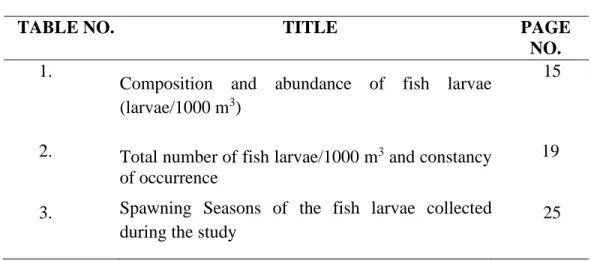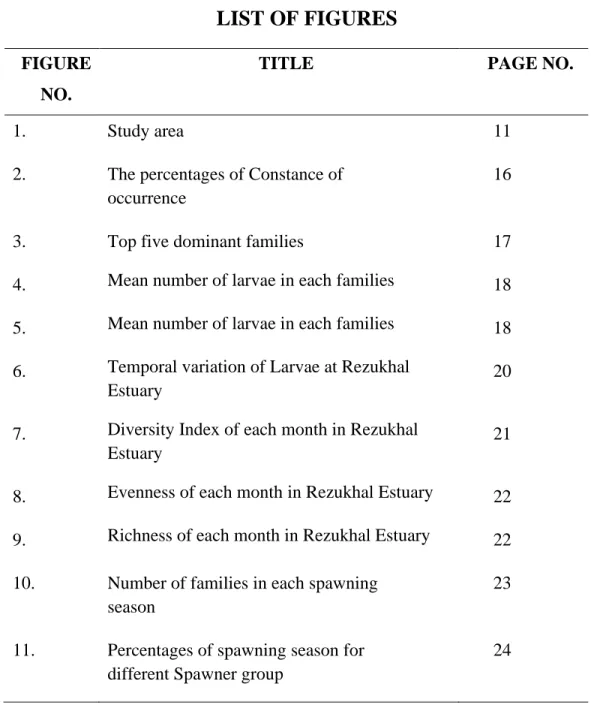The author expresses her deepest sense of gratitude and sincere appreciation to her esteemed teacher and research supervisor, Dr. The author also expresses her sincere gratitude to her co-supervisor, Shahida Arfine Shimul, Assistant Professor, Department of Fisheries Resource Management, Chattogram Veterinary and Animal Sciences University, Chattogram for her valuable guidance, intellectual suggestions, knowledge , the patience and time to teach him to be a more confident person to use in the world of work. The author is extremely happy to take this opportunity to express her heartfelt thanks and gratitude to all her respected teachers of Faculty of Fisheries, Chattogram Veterinary and Animal Sciences University, Chattogram for their valuable teaching and constant encouragement throughout the study period.
The author would like to thank laboratory technician Sopria Biswas and laboratory technician Bokhteyar Hasan and all the employees of the aquatic ecology laboratory for their cooperation in laboratory analyses. Finally, the author expresses her heartfelt gratitude to her beloved parents Sirajul Islam Chowdhury and Rehena Akter and her sisters and brother for their selfless love, blessings, care, dedicated efforts, precious prayers and constant support in academic life. Abundance and diversity of fish larvae on the Cox's Bazar Coasts, Bangladesh were investigated using a bongo net with a mouth diameter of 0.50 m, a length of 1.3 m and a mesh size of 500 μm on the body.
Fish larvae were collected from March 2020 to February 2021 at a research station called the Rezukhal Estuary, Cox's Bazar Coasts. The spawning season of the identified families was classified as Winter, Summer and Monsoon based on the monthly abundance of larvae.

LIST OF PLATES
LIST OF APPENDICES
LIST OF ABBREVIATIONS
- Significance of the study
- Scopes of the study
- Objectives
- Sampling procedure
- Fish larvae sorting
- Morphological identifications of larval fish
- Determination of abundance of larvae
- The constancy of occurrence
- Determination of the Ecological indices of the fish larvae
- Determination of the spawning season
- Analysis and visualization of collected data
- Constance of Occurrence
- Top Five Dominant families
The species is found in the sunlight zone of the water column, often called the epipelagic or photic zone, and is less than 200 meters deep (Stephens et al., 2006). Although some information on fish larvae has been collected in some coastal areas of the Bay of Bengal, nothing is known about the distribution and abundance of fish larvae in the offshore parts of the Rezukhal estuary, Cox's Bazar Coasts. This study provides a comprehensive insight into the abundance and distribution of fish larvae in the Rezukhal estuary, Cox's Bazar coast.
To identify larval fishes and estimate their temporal distribution in the Rezukhal estuary, Cox's Bazar coast. The purpose of this chapter is to review some of the previous research done by various researchers in the relevant field. It was divided between 18 families in the upper part of the Gulf, 19 families in the western part of the Gulf and 51 families in the Andaman Sea (Lirdwitayaprasit et al., 2008).
In the Pendas Estuary in Peninsular Malaysia, 2687 larvae from 19 families were found, including 14 in the upper estuary, 17 in the middle estuary and 16 in the lower estuary (Arshad et al., 2012). The percentages by families of constant occurrence among the 18 families in the upper part of the bay are constant as follows: accessory: accidental families were 28:22:50;. In the upper part of the Bay of Bengal, 07 (Carangidae, Gempylidae, Cynoglossidae, Bothidae, Scombridae, Sphyraenidae and Hemirhamphidae) of larvae were economically significant where Carangidae, Scombridae and Gempylidae were the most common families among them.
The most abundant families were Tripterygiidae and Phosichthyidae, which accounted for 8.2 % and 5.4 % of the total, respectively (Abu El-Regal et al., 2014). In the Pendas River estuary, southern Johor, Peninsular Malaysia, 05 dominant families (Blenniidae, Clupeidae, Gobiidae, Teraponidae and Sillaginidae) were identified (Arshad et al., 2012). The maximum household richness (1.72) was found in the middle estuary, while the lowest richness was found in the upper estuary (1.34) (Arshad et al., 2012).
In March and April, mature females were collected in the Caribbean Sea (Munro et al., 1973). In Yenliao Bay, northeastern Taiwan, the number of fish species in inshore areas was similarly higher than in inshore areas. The abundance of fish larvae is related to the seasonal variation in the number of species of fish larvae.
S = number of individuals of a species, N = total number of all individuals in the sample, ln = natural logarithm). Where, S=total number of species, N=total number of individuals in the sample and ln=natural logarithm.
Constance of Occurrence
Temporal variation of larval abundance
Biodiversity indices of the fish larvae
- Shannon-Wiener Diversity Index
- Pielou's evenness index
- Margalef Richness index
In the Rezukhal estuary, September had the highest number of relatives (08), while June had the lowest number (0) of relatives (Figure 6). This study has identified 15 families that appear to have less diversity than previous research in different parts of the Indian Ocean. Young et al., (1986) recorded 103 fish larvae families in the southeastern Indian Ocean, while Lidwitayaprasit et al.
In the Tropical Eastern Indian Ocean, Beckley et al., (2019) found 92 neritic and 21 mesopelagic teleost families. Nellen (1973) found 102 larval families in the Indian Ocean's north-eastern region, including the Arabian Sea, Red Sea and Persian Gulf. In the Indian Ocean, Rathnasuriya et al., (2021) identified 80 species belonging to 69 larval families using morphological and molecular methods.
Chesalina et al., (2013) found 40 families of larval fishes in the southwestern part of the Sea of Oman, which indicated the findings of the present study. The findings showed a low number of continuous families in the Rezukhal estuary, off the coast of Cox's Bazar. However, Lirdwitayaprasit et al., (2008) reported several constant (28) and subsidiary (22) families in the Bay of Bengal and 50 families were considered accidental.
Lirdwitayaprasit et al. (2008) recognized that Photichthyidae, Myctophidae, Bregmacerotidae, Gonostomatidae, Callionymidae and Carangidae are recognized as numerous families in the Bay of Bengal. In southern Johor, Peninsular Malaysia, the highest evenness (0.77) was found in the middle estuary and there were no differences in evenness between higher and lower estuaries (Arshad et al., 2012). Mulid larvae were common in the Arabian Gulf from late spring to autumn, but few in winter (Houde et al., 1986).
Understanding the abundance and distribution of fish larvae in relation to environmental conditions could fill a gap in the study of fish life cycles and provide useful information for fisheries management. Fish larval composition and spatial and temporal variation in the Pendas River Estuary, southwestern Johor, Peninsular Malaysia. Structuring larval fish assemblages along a coastal-ocean gradient in the macrotidal, tropical eastern Indian Ocean.
Species composition, community structure and zoogeography of fishes from mangrove estuaries in the Solomon Islands. Composition and diversity of larval fishes in the Indian Ocean using morphological and molecular methods.
